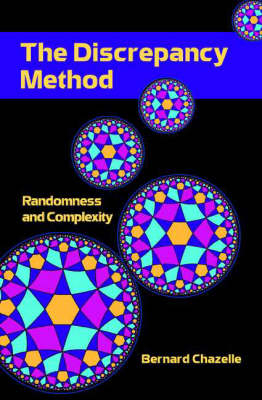
The Discrepancy Method
Randomness and Complexity
Seiten
2002
Cambridge University Press (Verlag)
978-0-521-00357-5 (ISBN)
Cambridge University Press (Verlag)
978-0-521-00357-5 (ISBN)
The discrepancy method is the most fruitful line of attack on the pivotal question: what is the computational power of random bits? This book includes such topics as communication complexity, pseudo-randomness, rapidly mixing Markov chains, derandomization, convex hulls and Voronoi diagrams, linear programming, geometric sampling and VC-dimension theory, and multidimensional searching.
The discrepancy method is the glue that binds randomness and complexity. It is the bridge between randomized computation and discrepancy theory, the area of mathematics concerned with irregularities in distributions. The discrepancy method has played a major role in complexity theory; in particular, it has caused a mini-revolution of sorts in computational geometry. This book tells the story of the discrepancy method in a few short independent vignettes. It is a varied tale which includes such topics as communication complexity, pseudo-randomness, rapidly mixing Markov chains, points on the sphere and modular forms, derandomization, convex hulls, Voronoi diagrams, linear programming and extensions, geometric sampling, VC-dimension theory, minimum spanning trees, linear circuit complexity, and multidimensional searching. The mathematical treatment is thorough and self-contained. In particular, background material in discrepancy theory is supplied as needed. Thus the book should appeal to students and researchers in computer science, operations research, pure and applied mathematics, and engineering.
The discrepancy method is the glue that binds randomness and complexity. It is the bridge between randomized computation and discrepancy theory, the area of mathematics concerned with irregularities in distributions. The discrepancy method has played a major role in complexity theory; in particular, it has caused a mini-revolution of sorts in computational geometry. This book tells the story of the discrepancy method in a few short independent vignettes. It is a varied tale which includes such topics as communication complexity, pseudo-randomness, rapidly mixing Markov chains, points on the sphere and modular forms, derandomization, convex hulls, Voronoi diagrams, linear programming and extensions, geometric sampling, VC-dimension theory, minimum spanning trees, linear circuit complexity, and multidimensional searching. The mathematical treatment is thorough and self-contained. In particular, background material in discrepancy theory is supplied as needed. Thus the book should appeal to students and researchers in computer science, operations research, pure and applied mathematics, and engineering.
1. Combinatorial discrepancy; 2. Upper bounds in geometric discrepancy; 3. Lower bounds in geometric discrepancy; 4. Sampling; 5. Geometric searching; 6. Complexity lower bounds; 7. Convex hulls and Voronoi diagrams; 8. Linear programming and extensions; 9. Pseudo-randomness; 10. Communication complexity; 11. Minimum spanning trees; A. Probability theory; B. Harmonic analysis; C. Convex geometry.
| Erscheint lt. Verlag | 14.1.2002 |
|---|---|
| Zusatzinfo | 160 Line drawings, unspecified |
| Verlagsort | Cambridge |
| Sprache | englisch |
| Maße | 152 x 229 mm |
| Gewicht | 652 g |
| Themenwelt | Mathematik / Informatik ► Informatik ► Theorie / Studium |
| Mathematik / Informatik ► Mathematik ► Arithmetik / Zahlentheorie | |
| ISBN-10 | 0-521-00357-1 / 0521003571 |
| ISBN-13 | 978-0-521-00357-5 / 9780521003575 |
| Zustand | Neuware |
| Haben Sie eine Frage zum Produkt? |
Mehr entdecken
aus dem Bereich
aus dem Bereich
Grundlagen – Anwendungen – Perspektiven
Buch | Softcover (2022)
Springer Vieweg (Verlag)
34,99 €
Eine Einführung in die Systemtheorie
Buch | Softcover (2022)
UTB (Verlag)
25,00 €
was jeder über Informatik wissen sollte
Buch | Softcover (2024)
Springer Vieweg (Verlag)
37,99 €


